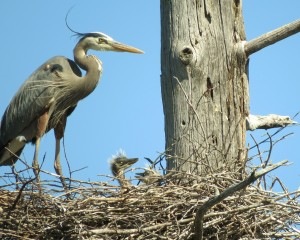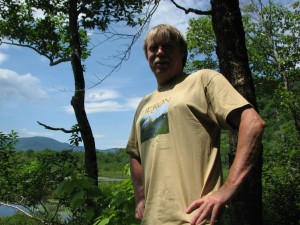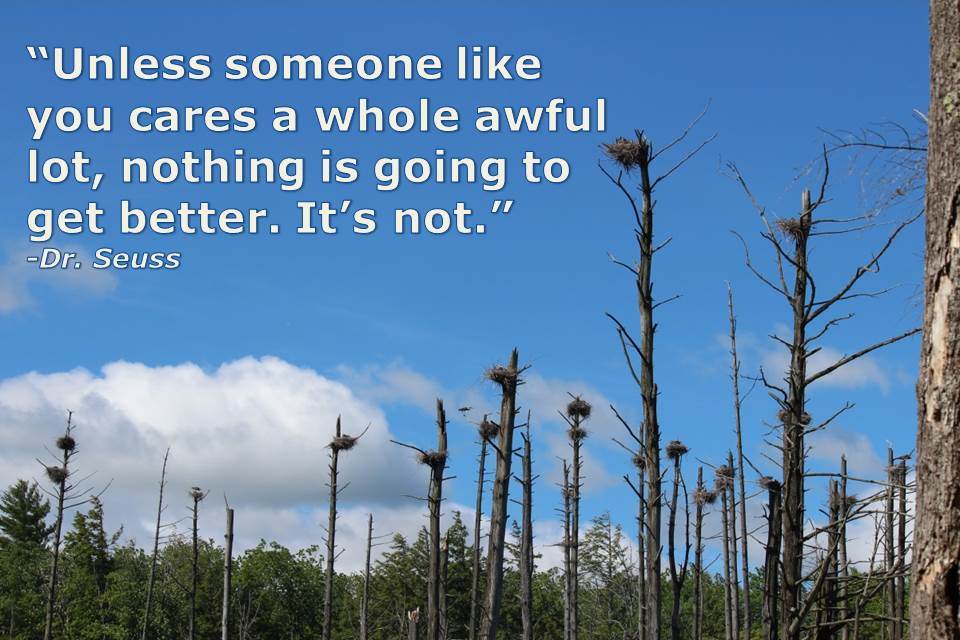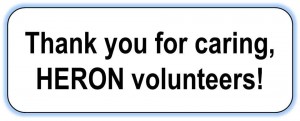December 17, 2014 at 1:08 pm
[caption id="attachment_1191" align="alignleft" width="300"] Photo by Victor Morin[/caption]
In only six years, the Heron Observation Network grew from 78 to 246 volunteer members! Just as Dr. Seuss said, “a person is a person no matter how small,” a member is a member no matter how many colonies they adopt! Each member is invaluable in that he or she possess a unique understanding of the HERON program and its accomplishments, and likely passes on their knowledge to others even if just in casual conversation. I believe this is how we’ve grown to the size we are today.
More members means more ACTIVE volunteers and ultimately more colonies adopted and monitored. Here are some quick stats for 2014:
Photo by Victor Morin[/caption]
In only six years, the Heron Observation Network grew from 78 to 246 volunteer members! Just as Dr. Seuss said, “a person is a person no matter how small,” a member is a member no matter how many colonies they adopt! Each member is invaluable in that he or she possess a unique understanding of the HERON program and its accomplishments, and likely passes on their knowledge to others even if just in casual conversation. I believe this is how we’ve grown to the size we are today.
More members means more ACTIVE volunteers and ultimately more colonies adopted and monitored. Here are some quick stats for 2014:
 HERON volunteer, Mark Lewonis, sporting his free T-shirt![/caption]
The number of active nests and colonies was very similar to what we observed and estimated the past 5 years. The habitat setting also showed a similar breakdown to past years, with 77% of colonies occurring in beaver flowages and more than 50% of the state’s nesting pairs concentrated in just 10 colonies. Our coastal sites appear to be shifting around a bit, making it difficult to keep tabs on the active sites. In 2014, our incomplete survey of coastal islands estimated activity on 11 coastal islands, with approximately 275 pairs.
This year was not only exciting because of the number of people actively involved, but also because we tested a few hypotheses regarding sources of disturbance at great blue heron colonies. The results of those studies will be detailed in another post or two, so stay tuned. I promise it will be interesting and slightly disturbing.
Allow me to close with another reference to the great work of Dr. Seuss (and a colony that reminds me of Truffula trees)...
[caption id="attachment_1194" align="aligncenter" width="960"]
HERON volunteer, Mark Lewonis, sporting his free T-shirt![/caption]
The number of active nests and colonies was very similar to what we observed and estimated the past 5 years. The habitat setting also showed a similar breakdown to past years, with 77% of colonies occurring in beaver flowages and more than 50% of the state’s nesting pairs concentrated in just 10 colonies. Our coastal sites appear to be shifting around a bit, making it difficult to keep tabs on the active sites. In 2014, our incomplete survey of coastal islands estimated activity on 11 coastal islands, with approximately 275 pairs.
This year was not only exciting because of the number of people actively involved, but also because we tested a few hypotheses regarding sources of disturbance at great blue heron colonies. The results of those studies will be detailed in another post or two, so stay tuned. I promise it will be interesting and slightly disturbing.
Allow me to close with another reference to the great work of Dr. Seuss (and a colony that reminds me of Truffula trees)...
[caption id="attachment_1194" align="aligncenter" width="960"] Photo by Leigh MacMillen Hayes[/caption]
Photo by Leigh MacMillen Hayes[/caption]

 Photo by Victor Morin[/caption]
In only six years, the Heron Observation Network grew from 78 to 246 volunteer members! Just as Dr. Seuss said, “a person is a person no matter how small,” a member is a member no matter how many colonies they adopt! Each member is invaluable in that he or she possess a unique understanding of the HERON program and its accomplishments, and likely passes on their knowledge to others even if just in casual conversation. I believe this is how we’ve grown to the size we are today.
More members means more ACTIVE volunteers and ultimately more colonies adopted and monitored. Here are some quick stats for 2014:
Photo by Victor Morin[/caption]
In only six years, the Heron Observation Network grew from 78 to 246 volunteer members! Just as Dr. Seuss said, “a person is a person no matter how small,” a member is a member no matter how many colonies they adopt! Each member is invaluable in that he or she possess a unique understanding of the HERON program and its accomplishments, and likely passes on their knowledge to others even if just in casual conversation. I believe this is how we’ve grown to the size we are today.
More members means more ACTIVE volunteers and ultimately more colonies adopted and monitored. Here are some quick stats for 2014:
- 32 new great blue heron colonies were reported or found since August 2013
- 8 MDIFW staff and contract workers plus 72 volunteers monitored over 171 great blue heron colonies
- 34 colonies were surveyed from the air
- 25 colonies were surveyed from both the air and ground
- 112 were surveyed from the ground (over 383 ground visits conducted)
- 96 colonies were active with approximately 928 pairs observed
- 72 colonies containing at least 103 nests showed no sign of activity
- We estimate 105 active colonies with 1,091 pairs statewide, after accounting for sites not surveyed
- Volunteers documented 730 hours and 6,545 miles, which will be used as match for federal funding
- Over 80 volunteers received a free T-shirt
 HERON volunteer, Mark Lewonis, sporting his free T-shirt![/caption]
The number of active nests and colonies was very similar to what we observed and estimated the past 5 years. The habitat setting also showed a similar breakdown to past years, with 77% of colonies occurring in beaver flowages and more than 50% of the state’s nesting pairs concentrated in just 10 colonies. Our coastal sites appear to be shifting around a bit, making it difficult to keep tabs on the active sites. In 2014, our incomplete survey of coastal islands estimated activity on 11 coastal islands, with approximately 275 pairs.
This year was not only exciting because of the number of people actively involved, but also because we tested a few hypotheses regarding sources of disturbance at great blue heron colonies. The results of those studies will be detailed in another post or two, so stay tuned. I promise it will be interesting and slightly disturbing.
Allow me to close with another reference to the great work of Dr. Seuss (and a colony that reminds me of Truffula trees)...
[caption id="attachment_1194" align="aligncenter" width="960"]
HERON volunteer, Mark Lewonis, sporting his free T-shirt![/caption]
The number of active nests and colonies was very similar to what we observed and estimated the past 5 years. The habitat setting also showed a similar breakdown to past years, with 77% of colonies occurring in beaver flowages and more than 50% of the state’s nesting pairs concentrated in just 10 colonies. Our coastal sites appear to be shifting around a bit, making it difficult to keep tabs on the active sites. In 2014, our incomplete survey of coastal islands estimated activity on 11 coastal islands, with approximately 275 pairs.
This year was not only exciting because of the number of people actively involved, but also because we tested a few hypotheses regarding sources of disturbance at great blue heron colonies. The results of those studies will be detailed in another post or two, so stay tuned. I promise it will be interesting and slightly disturbing.
Allow me to close with another reference to the great work of Dr. Seuss (and a colony that reminds me of Truffula trees)...
[caption id="attachment_1194" align="aligncenter" width="960"] Photo by Leigh MacMillen Hayes[/caption]
Photo by Leigh MacMillen Hayes[/caption]
